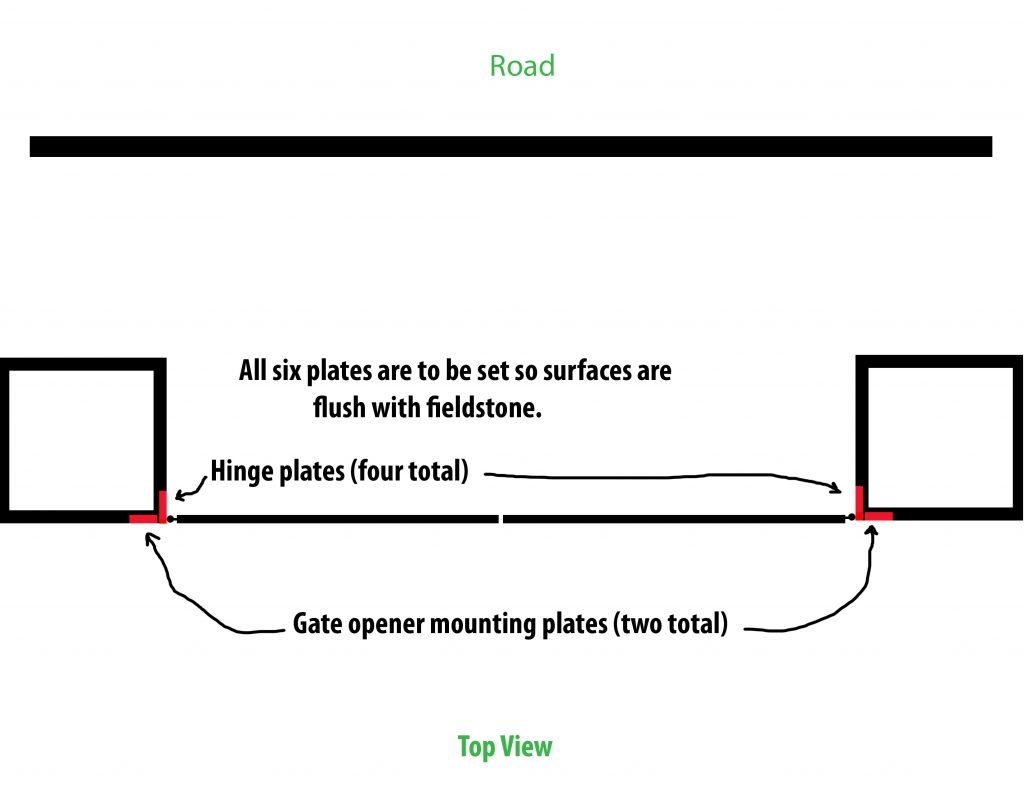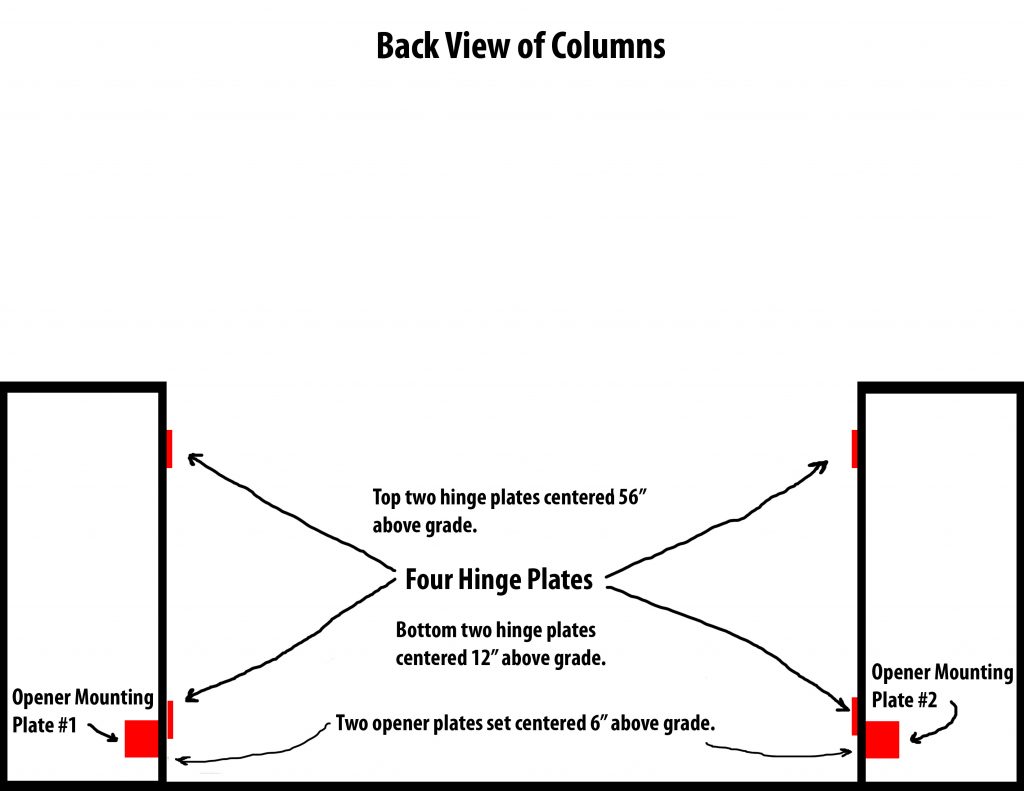Your Ultimate DRIVEWAY GATE Planning & INSTALLATION GUIDE
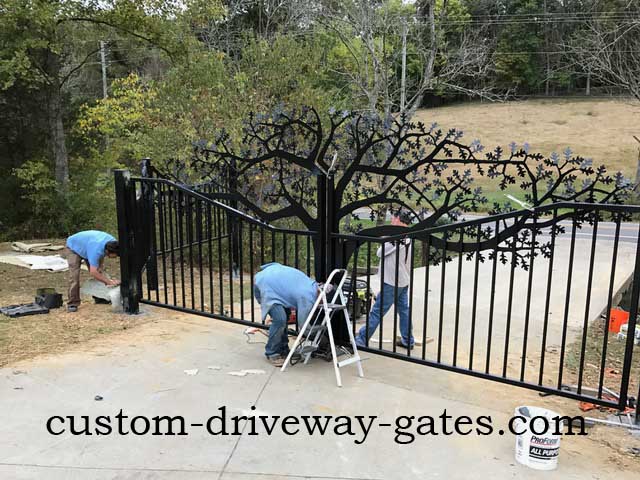
When planning your upcoming driveway gate project, you need to first evaluate your driveway gate site. But how?
In this tutorial we walk you through the steps you need to take before purchasing your new driveway gate. We finish up by discussing the actual installation itself.
Stage 1: Evaluating Your Gate Site
The most important step of your entire upcoming project is the site evaluation. You want to know where to locate the gate and how to set it up. Answering the following questions will help you avoid all kinds of potential issues and ensure you are happy with your end result.
1. How wide should my driveway gates be?
First things first, you want to consider the size of vehicles and/or machinery potentially coming through your entrance gates.
12′ is the smallest gate width we recommend for driveways. This is often the perfect size for a residential entry gate. However, some localities require a minimum of 14′ opening space (168″) to allow emergency response vehicles adequate clearance to enter.
For busier farms, ranches or estates we recommend at least a 16′ wide driveway gate to easily accommodate larger vehicles and more traffic.
You will almost always want a minimum of 6″ distance between the edge of the driveway and the gate posts (or masonry columns). For example, a 15′ wide asphalt driveway needs 16′ or more distance between the posts or columns.
If your gate is going to be situated on a sharp curve in the driveway, the gate will constrain longer vehicles such as RV’s and trucks with trailers as they turn. In this case, factor in enough extra clearance on each side of the driveway to accommodate the gates when they are in the open position. And of course, it’s always better to err on the side of safety.
2. Should I choose a single swing gate or a dual swing gate?
When we talk about “single swing” and “dual swing”, we are referring to whether one single gate panel spans the entire width of the opening between the gate posts (single swing), or two equally sized gate panels each cover half the span (dual swing).

While single swing gates can be built to span up to an 18′ opening, we normally recommend that spans over 14′ wide to be covered by a dual swing gate.
3. Which direction should my gate(s) swing open?
“Pull to Open” VS. “Push to Open“
Imagine for a moment that you are standing at your closed gate. The road is located on the other side of your gate and you are on the inside of the property. If you pull the gate opens towards you this is called “pull to open”. If you open the gates by pushing them towards the road this is called “push to open”.
Driveway gates that are operated by hand can usually work “either or”.
But when a driveway gate opener is added into the equation, the movement of the gate is mechanically restricted so it can only operate as a “push to open” or “pull to open”, but not both. This means that one dedicated direction is chosen for the gate to swing as it opens.
Most of the time automatic driveway gates with openers are oriented to “pull to open”, swinging open inward towards the property and away from the road.
One important thing to consider is that a sloped driveway, if it is steep enough, limits the direction of swing because the driveway gate will hit the ground and not open or close fully.
Trees, rocks, fences or other obstructions in the vicinity can limit the direction of swing.
A single swing gate will require a larger area of clearance to swing fully open compared to a dual swing gate of the same width.
Finally, the largest gate openers are typically ground mounted and only work in the pull to open setup.
4. How far should my gate be from the road?
You will want to allow plenty of room for entering vehicles to pull safely off the road while the gate opens. Local codes typically require a driveway gate to be installed at least 50′ away from the center of the roadway.
5. How much ground clearance will my gate need?
A gate on a sloped driveway may need the bottom to be higher off the ground to clear the ground when swinging into the open position
At least 3″-4″ ground clearance should be maintained to allow for frost heave or other movement of the ground over time. Some areas are far more prone to ground movement than locations.
Areas with high snow accumulation may want to place the gate 12″ or more above the ground to avoid the gate jamming in the snow.
Areas prone to flooding should be avoided, especially if using a gate opener.
6. Accounting for Slope, Grade and Curves
The curve, slope & grade of the driveway will determine which direction the gates swing and how high off the ground the bottom of the gates will be in order to clear obstructions such as snow, flooding, grade, rocks, etc.
Slope of Driveway
Consider the slope of the driveway at the installation site. This is important to make sure the gate(s) can swing a full 90 degrees or more into the open position without swinging into the ground.
Below is an example of a driveway which slopes steeply upwards towards the home. These gates are required to swing out toward the road (“push to open”) or else they would not be able to clear the slope without adding 18-24″ of ground clearance beneath the gate panels which would look very awkward and not be very secure.

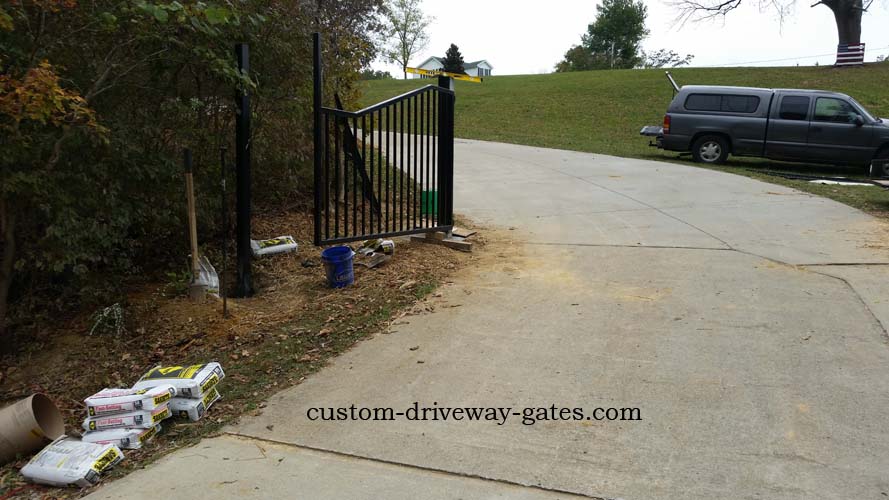

Flat Areas
Flat areas are ideal for installing gates because they are not restrictive on the direction of swing of the driveway gates. They can be set up for either push or pull to open.
Moderate Slope Upwards To Home
If the driveway slopes moderately upwards towards the property the gate opener can be installed in the “pull to open” manner only if the bottom of the gates are set high enough to clear the ground where the gates reside when they are in the open position. Otherwise, plan for “push to open” installation.
Heavy Slope Upwards Toward Home
If the driveway slopes too heavily upward towards the home, the gate(s) will need to swing out towards the road (push to open) in order to clear the ground in the open position.
Heavy Slope Upwards Toward Road
If the driveway slopes heavily upwards towards the road, the gate opener should be installed in the “pull to open” fashion.
Curved Areas
As stated above; curved areas should take into account RV’s, landscaping trailers and other long vehicles and machinery that may pass through and have a hard time making a sharp corner. It’s ideal to place the gate at a straight section of the driveway.
7. Will My Gate Be Manually or Automatically Opened?
If your gate will be manually opened, it will require a latch, drop pins or another method to secure the gate in the open or closed position and to keep it from swinging freely in the wind.
If using electrically powered gate openers, the opener mechanisms hold the gates in place to prevent them from swinging in the wind
Automatic gate openers require a power supply at the site. If 120 volt power is not available then solar power is a great option as long as the site gets at least 4 hours of direct sunlight per day all year round.
Automatic Openers: Dual Swing vs. Single Swing Considerations:
Dual swing gates with electric gate openers will require a conduit to be run through a trench beneath the driveway to get power and accessory wires from the “master” operator to the “slave” operator.
Some gate operators that communicate wirelessly can now be purchased, thus obviating the need for an operator control wire. This power wire is not necessary for a single swing operator unless the operator power supply is coming from the other side of the driveway.
Stage 2: Preparing For Your Driveway Gate Installation
Once the factors listed above are accounted for, the next task at hand is preparing the gate site for installation.
There are several methods of installing your gates. For the purposes of these instructions, we are going to assume that the gates are being installed on metal posts. Customers who are installing the gates on columns should go to the bottom of this tutorial for further instructions.
Single swing gates are the easiest to install. Dual swing gates are more involved because they have to line up with each other to look good.
***IMPORTANT: Always Leave Extra Clearance for Gate Hinges***
For our driveway gates, always remember to add 5″-6″ of extra space per gate panel to allow room for the hinges.
Also add approximately 1″ to allow for an opening gap between the gate and “latch” post (single swing) or between the two gate panels (dual swing). The goal here is to leave enough room so the gates don’t rub together and hands won’t get smashed in the opening.
For single swing gate installations you should leave an extra 6″ of space between the gate posts. So for example, a 12′ wide gate panel needs 12′ 6″ of space between the gate posts.
For dual swing gate installations, leave an extra 11 to 12“ between posts for dual swing application. See below for examples.
Example #1: Setting Single Swing Gates:
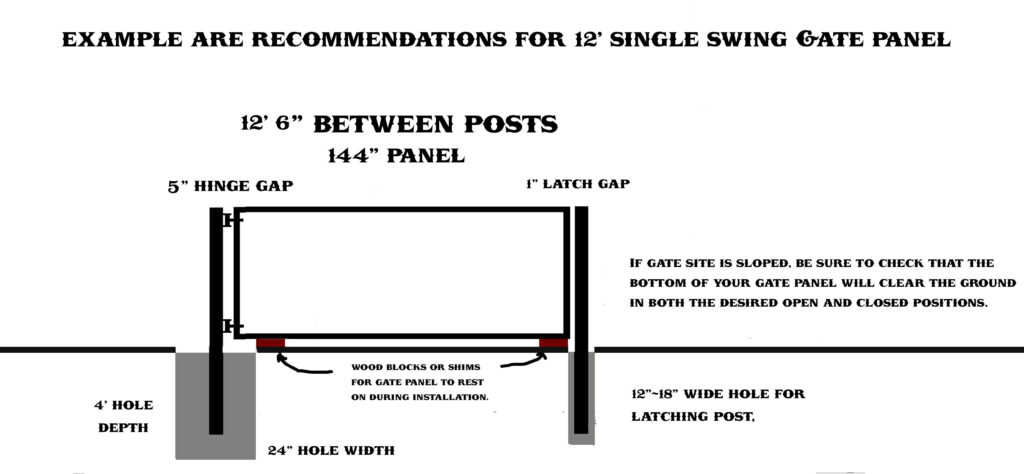
The example shown above is for a 12′ single swing gate. Substitute your own exact single swing gate panel width measurements, the gaps should still be the same no matter the gate size.
Example #2: Setting Dual Swing Gates:
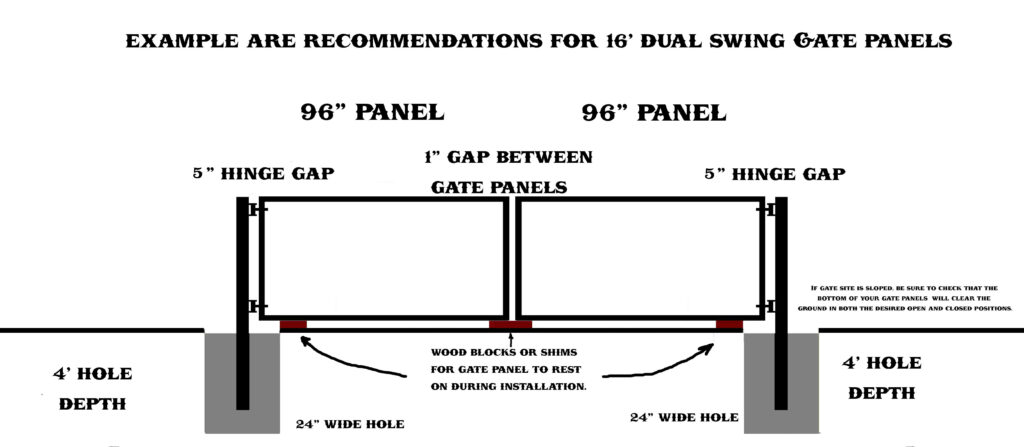
*The example shown above is for a 16′ dual swing gate. Substitute your own exact (dual swing) gate panel width measurements, the gaps should still be the same no matter the gate size.
General Installation Considerations:
1. What size should the post holes be?

36″ should be the minimum depth for a post hole, but the bottom of the hole must be deeper than frost line. Rocky areas may not be able to go 36″ deep, in these cases just go as deep as possible and make a wider hole. In all cases the width of the hole will be determined by the size and weight of the gate. A larger gate will require a wider and/or deeper hole. The post holes are typically at least 24″ wide at the top.
It’s much better to excavate a square hole rather than round. The flat sides better resist tilting of the posts over time.
In areas with softer soil, go wider at the bottom than the top so the hole has an overall “bell” shape. This gives the concrete a nice flat bottom to sit on to evenly distribute the weight and keep the post from tilting over time.
The post hole should be several inches deeper than the bottom of the gate post in the hole. This is to allow concrete to seal off the bottom of the post to keep water out. Otherwise the post is likely to suck up and retain water and rust from the inside out over time.
Concrete Truck:
Depending on the size of holes needed for your gate installation, it often makes sense to bring out a concrete truck.
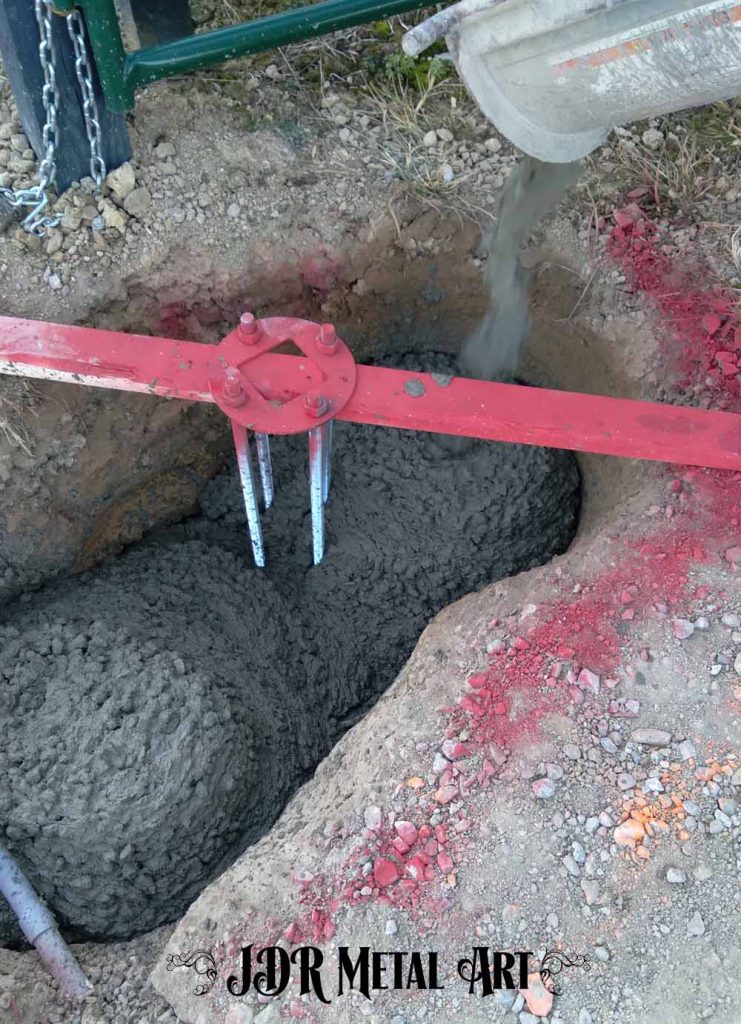
How much concrete to use:
Concrete serves the critically important role of holding the post(s) in place and keeping them from moving over time.
Unfortunately, despite the fact that concrete is the cheapest material that goes into a well-designed gate project; all too often gates are installed to gate posts that are set in an inadequate amount of concrete. That will allow the downward force of gravity on the gate to leverage the post over as the years (in bad cases, months or weeks) go by.
As a general rule of thumb for steel gates, there should be 100-150 lbs of concrete per foot of length per gate panel. A 10′ long steel gate panel should have from 1000 lbs to 1500 lbs of concrete in the post hole. Areas with hard clay or rocky soils will get by with less concrete. Areas with deep, soft topsoil or sandy soils should use 25-50% more concrete.
CLICK HERE FOR CONCRETE CALCULATOR
Aluminum gates can use approximately half the amount of concrete as would a steel gate.
How Far Do I Set the Posts Apart?
For Single Swing Gates that have a “dummy post” add 5″ to the width of the gate for hinges and 1″ for the opening gap. A 12′ gate panel requires 12′ 6″ clearance between the posts.
For Dual Swing Gates (Pull-to-open): Add 11″ to the overall combined width of the gate panels. A 20′ dual swing (two 10′ panels) will require 20’11″ between the posts. So the posts will be set 20′ 11″ apart I.D., inside to inside dimension. There will be a 5″ hinge space for each panel and a 1″ gap between the two gates.
Dual Swing Gates (Push-to-open): Add 11″ to the overall combined width of the gate panels. A 20′ dual swing (two 10′ panels) will require 20′ 11″ between the posts. So the posts will be set 20′ 10″ apart I.D., inside to inside dimension.
How Much Adjustment is in the Hinges?
In our gate hinges there is approximately 1-2″ of adjustment for each gate panel…in other words, each gate panel can be moved 1″ in towards the center of the driveway or 1″ out towards the gate post in order to adjust the gap sizes and perfectly level and align the gate(s). This allows a good amount of room for error in case the posts are not installed 100% plumb or the distance between the posts is off a bit.
Swing Gate Installation Methods
Method 1:
Set All Gate Posts 1st And Hang Gates A Few Days Later
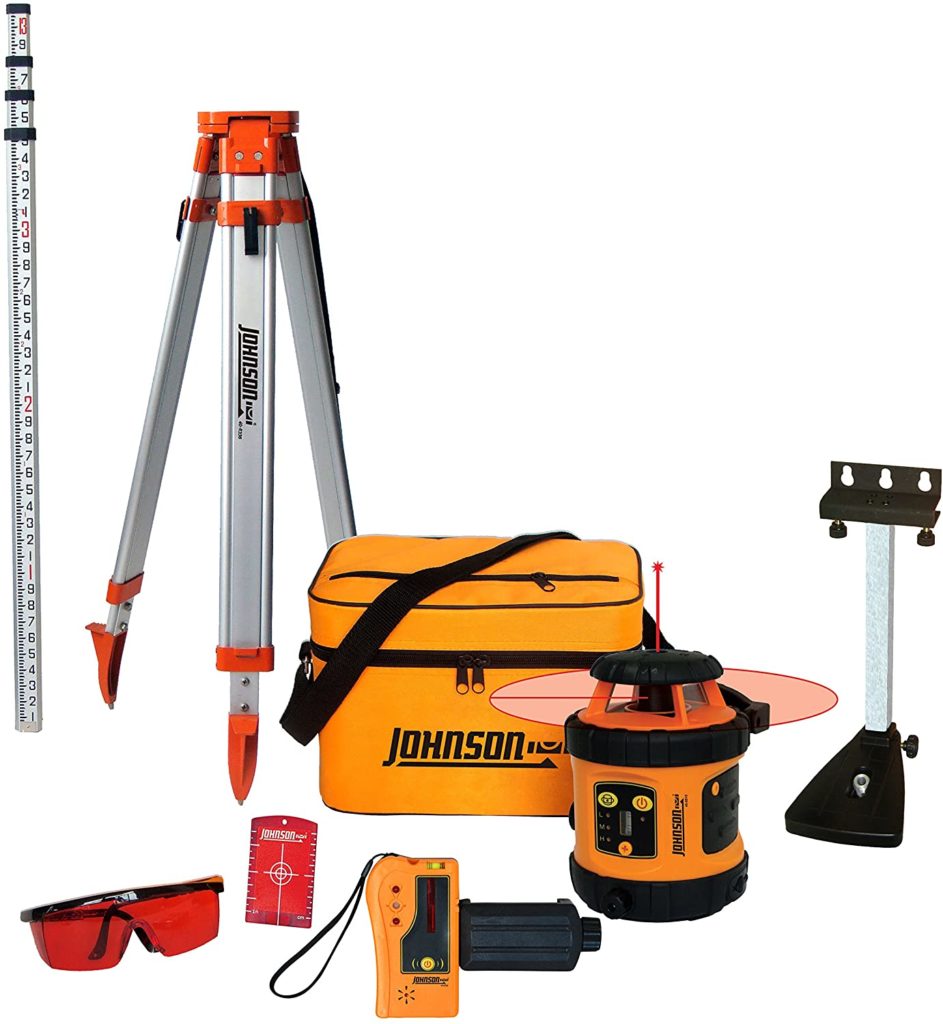
This method is best for experienced driveway gate installers who have a laser transit or other means to accurately place the posts first with the gates being hung to the posts only once the concrete has set up for several days. The driveway gate posts should always be level across tops, plumb both ways and the proper distance apart.
Without the proper measuring tools it can be very difficult to accurately place the posts so that they are plumb up and down as well as level across the tops. Placing one post too deep or shallow will result in the gates looking awkward and uneven and not level and straight as they should be.
*Be sure the gates will swing the desired direction without hitting the ground as they approach the open position.
Method 2:
Setting One Gate Post & Gate Panel At a Time On Blocks & Remove Blocks Later
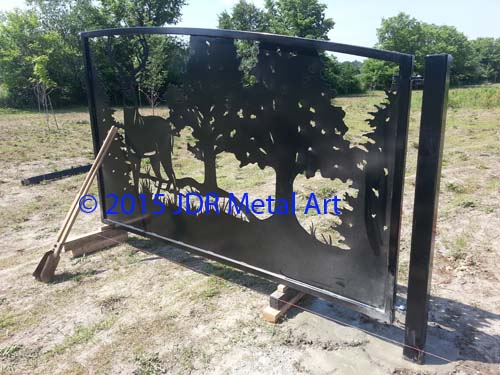
This method makes it easier to line the gates up properly. However, it’s more labor intensive and best to use three of four people to make this happen easily. By installing one side at a time it is easy to be sure that the gates and posts will line up properly. Focus on getting the first gate panel and its post in place; once that is done the second panel can be matched up to the 1st panel exactly as desired before setting the final post in concrete.
Driveway Gate Install Tips and steps:
1. Measure your gate panels: add 5″ per gate panel for hinge spacing (for our gates). Also, add another 1″ for a gap between the gates (for dual swing setup); or add 1″ gap between the gate and the latching post (for single swing setup). This is the distance that should be between the posts (i.d.) once they are both installed in the ground.
2. On the gate site locate, mark and dig the post holes to accommodate the amount of concrete required by your size of the gate. For example: on a 16′ dual swing gate, the posts would be placed 16′ 11″ apart. Another example is a 12′ single swing, which will require a total of 12′ 5″ space between the hinge post and the latch post. Once the holes are clean and free of any debris, if desired, place several inches of gravel in the bottom of the hole to facilitate drainage.
3. Place wood blocks or shims as shown in the diagrams above. The tops of the blocks must be level i.e. on the same horizontal plane. 2″x6″ or 2″x8″ wood blocks that are cut 16″ long and stacked on top of each other work well. Smaller shims can be used to build the tops to the same height. Screw or nail each pile The gates will be lifted on top of these blocks where they will rest during installation. If you are aiming for 6″ of ground clearance beneath the gate at the center of the driveway then you would want 6″ tall blocks in place. Be sure to leave enough ground clearance for snow, high water marks, etc.
4. If there is an uneven ground slope, now is the time to be sure the gate will have adequate ground clearance in both the desired open and closed positions. Be sure to start by installing the gate on the side that is on the higher part of the slope. A driveway with a higher grade on the left side would need to have the left side installed first. Installing them in the reverse order creates the potential for inadvertently installing the 1st gate too low for the 2nd gate to clear the ground as it swings open.
To be sure the gates will clear the slope you will need a straight edge the same length of the gate, a straight 2×4 board works well. One end of the straight edge is then placed where the gate hinges will pivot as the gate(s) swing into the open position.
5. Place the gate post in the post hole. Stand gate up on its blocks. Assemble post to the gate using hinge hardware. The hole should be several inches deeper than the bottom of the gate post so that the post bottom isn’t buried in dirt. If the post hole is too deep, simply put a concrete block and/or dry concrete into the bottom of the hole for the post to sit on top of. Ideally, there should be a few inches of concrete encapsulating the bottom of the post to prevent water from being sucked up through the bottom of the post.
Tighten hinge hardware so the post is plumb (straight up and down), pour concrete (hydrate, but not super wet) around the post while making sure the post remains plumb both ways. Both the gate and post should be kept plumb as the hole is filled with concrete. Also, make sure post and gate are square to each other before filling in with concrete.
6. If installing a dual swing, once the 1st gate panel is installed the 2nd gate will sit of the other half of the center block with the hinge side on its own block by the 2nd gate post to be installed. Repeat step 5 for 2nd gate and post.
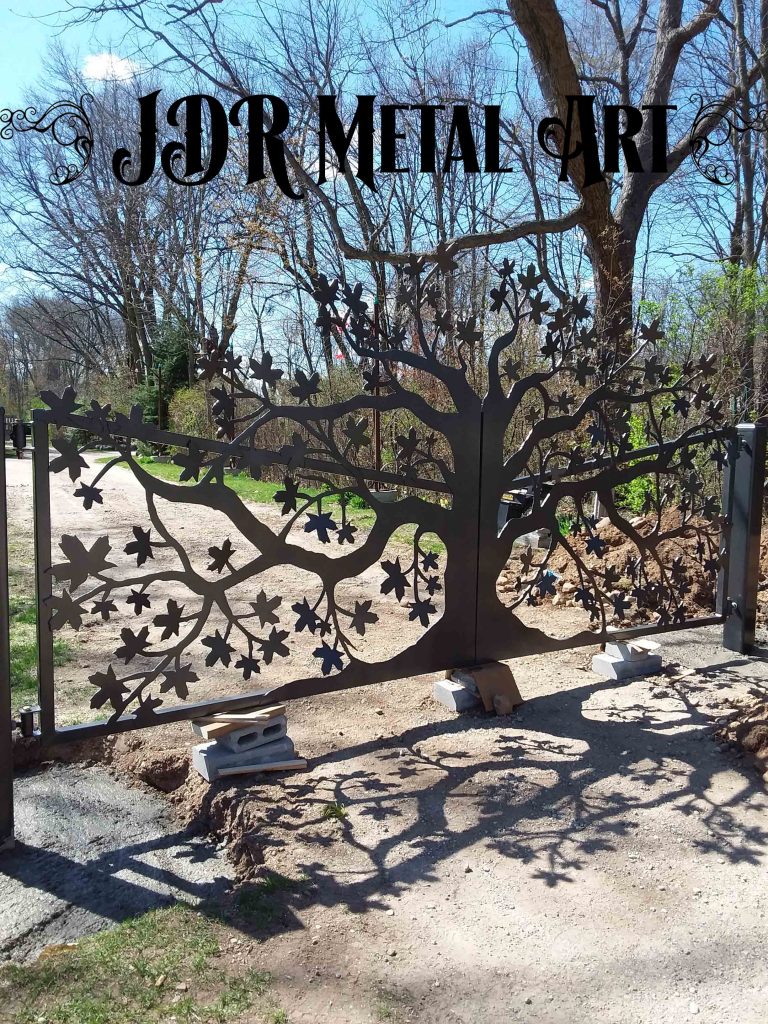
7. Allow concrete to set up at least 36 hours, preferably 48-72 hours before stressing the concrete by opening the gates. Allow the concrete to cure for several more days before putting the gates into service.
Installing Gates to Columns
Measurements vary by job. For reference purposes only.
